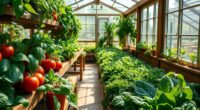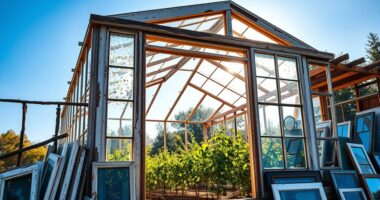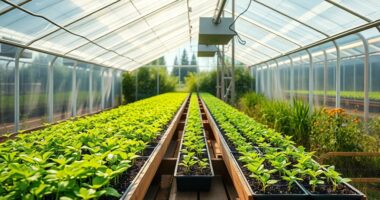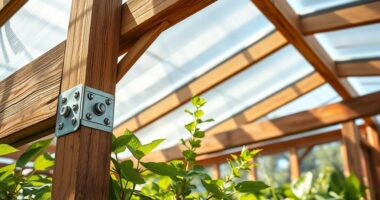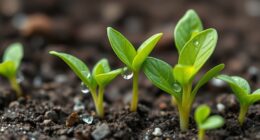To design an off-grid greenhouse, you should integrate solar panels for heating and energy, utilize reflective surfaces and thermal mass for heat retention, and position it for maximum sunlight access. Incorporate rainwater harvesting, multi-stage filtration, and self-sufficient water systems like drip irrigation to conserve water. Combine these features with renewable energy options such as solar thermal or hydrogen fuel cells. Continually optimizing these systems guarantees a sustainable environment—discover more ways to create your eco-friendly haven if you keep exploring.
Key Takeaways
- Maximize sunlight exposure and incorporate thermal mass to enhance heat retention and reduce reliance on external energy sources.
- Integrate solar panels and possibly hydrogen fuel cells for sustainable, off-grid power and temperature regulation.
- Collect rainwater and install multi-stage filtration systems for a reliable, eco-friendly water supply.
- Use water-efficient irrigation methods like drip or soaker hoses to conserve water and optimize plant health.
- Design systems to be scalable and interconnected, ensuring long-term resource sustainability and self-sufficiency.
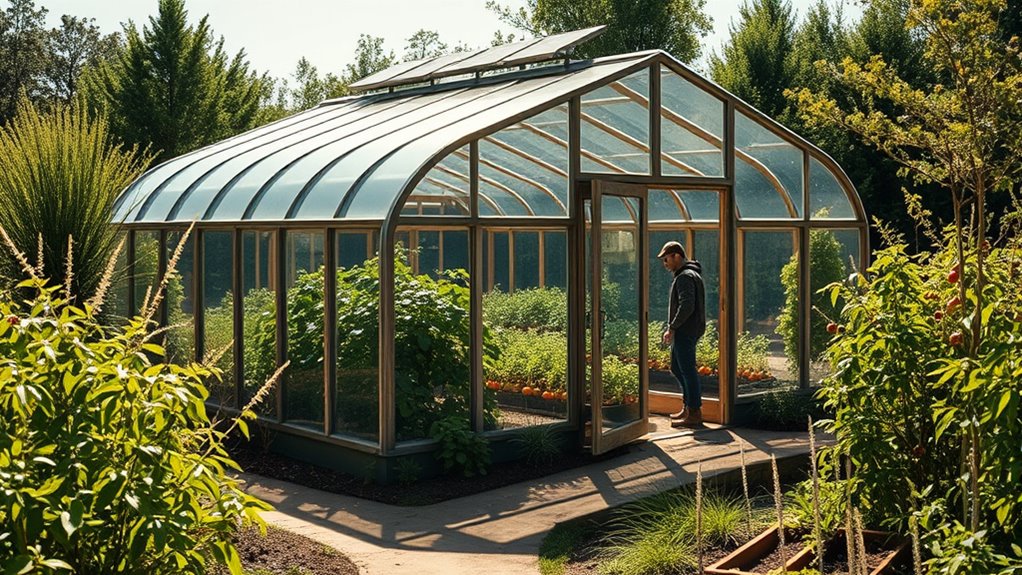
Living off-grid means relying on sustainable solutions to meet your daily needs, and a well-designed greenhouse can be an essential part of that system. When planning your greenhouse, consider integrating solar heating to keep temperatures stable without electricity. Solar panels can power fans or heating systems, harnessing sunlight to warm your space naturally. This not only reduces dependency on external energy sources but also guarantees your plants stay healthy throughout colder months. Position your greenhouse to maximize sunlight exposure, especially during winter, to optimize the effectiveness of your solar heating system. Installing reflective surfaces or thermal mass inside can also help retain heat, making your greenhouse more energy-efficient.
Water management is equally vital in off-grid living, so incorporating an effective water filtration system into your greenhouse design is a smart move. Collecting rainwater from the roof can provide a sustainable water source, but you’ll need to filter it to guarantee purity. A good water filtration setup removes contaminants and sediments, making water safe for your plants and possibly for household use. You might consider installing a multi-stage filter that includes a sediment filter, activated charcoal, and UV sterilization, depending on your water source. Incorporate these components into your greenhouse’s plumbing to create a self-sufficient water cycle. This way, you won’t have to rely on external water supplies, reducing your environmental footprint.
Designing your greenhouse with water conservation in mind is also essential. Use drip irrigation or soaker hoses to minimize water waste and deliver moisture directly to plant roots. Position your greenhouse near a water collection system to make maintenance easier and guarantee consistent water supply. Additionally, consider including a small storage tank for filtered water, so you always have a reserve during dry spells or cloudy days when rain collection might be limited.
Combining solar heating with water filtration creates a resilient, eco-friendly environment for your plants. Not only does it help you maintain a stable climate, but it also guarantees your water supply remains clean and reliable. These systems work synergistically to reduce your reliance on external resources, making your off-grid lifestyle more sustainable. Proper planning and integration of these elements into your greenhouse design will pay off in the long run, providing you with fresh produce and peace of mind. Living off-grid demands resourcefulness—by focusing on renewable energy and water solutions, you’re building a self-sufficient home that respects the environment while meeting your needs. Additionally, utilizing hydrogen fuel cells for energy storage can further enhance your off-grid setup by providing a clean and efficient power source during periods of low sunlight or high energy demand.
Frequently Asked Questions
What Are the Best Materials for Insulating an Off-Grid Greenhouse?
You should choose materials with excellent thermal insulation, like double-glazed polycarbonate or insulated panels, to keep your greenhouse warm. Incorporate moisture barriers such as vapor barriers or waterproof paints to prevent humidity issues. These materials help maintain a stable temperature and protect against moisture buildup, ensuring a healthy environment for your plants. Combining high-quality insulation with moisture barriers creates an efficient, off-grid greenhouse that thrives year-round.
How Can I Maximize Natural Ventilation in My Greenhouse?
You can maximize natural ventilation through passive cooling by strategically placing vents and windows to promote airflow optimization. Start by installing adjustable vents at both the roof and sides to facilitate cross-ventilation, which cools the greenhouse naturally. Consider using ceiling fans or exhaust fans powered by solar energy for additional airflow control. Regularly opening and closing vents based on outdoor conditions guarantees consistent airflow, keeping your greenhouse comfortable without relying on external power sources.
What Are Cost-Effective Renewable Energy Options for Greenhouse Heating?
You should consider solar thermal systems and biomass heating for cost-effective renewable energy options. Solar thermal collectors capture sunlight to heat water or air, providing an efficient, low-cost solution. Biomass heating uses organic materials like wood or crop waste, offering a sustainable, affordable way to maintain warmth. Both options reduce reliance on fossil fuels and help you keep your greenhouse warm naturally and economically.
How Do I Prevent Pests Without Chemical Pesticides?
Imagine pests invading like an unstoppable army—you can stop them naturally! You should practice companion planting, pairing plants that repel pests with your crops. Encourage natural predators, like ladybugs and birds, to patrol your greenhouse and keep pests in check. Regularly inspect your plants, remove affected leaves, and maintain healthy soil. These methods create an unstoppable barrier against pests, keeping your greenhouse thriving without harmful chemicals.
What Is the Ideal Size for an Off-Grid Greenhouse?
You should aim for a greenhouse around 100 to 200 square feet, balancing ample space with efficiency. Incorporate solar shading to regulate temperature and prevent overheating, and install water harvesting systems to maximize water use. This size allows you to grow a variety of plants while maintaining off-grid independence. Keep in mind, a manageable size helps you control pests naturally and reduces energy and resource demands.
Conclusion
So, now that you’ve built your off-grid greenhouse, you’re basically a plant whisperer with a solar-powered green thumb. Who needs fancy grocery stores when you can grow your own food and bask in the glow of self-sufficiency? Just remember, the real challenge isn’t keeping plants alive—it’s resisting the urge to turn your backyard into a botanical paradise that makes neighbors jealous. Happy gardening, eco-warrior!

